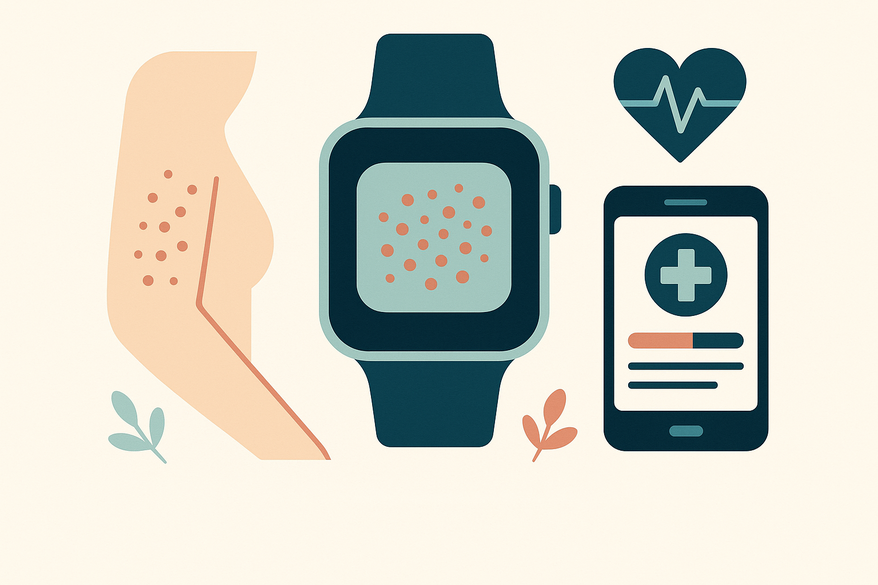Integrating Rash Detection into Wearable Devices for Skin Health
Learn how integrating rash detection into wearable devices for skin health can enhance early intervention, improve patient outcomes, and personalize wellness.

Estimated reading time: 8 minutes
Key Takeaways
- Continuous monitoring of hydration, temperature, and barrier function transforms dermatology care.
- Rash detection integration enables early alerts for allergic reactions, infections, and chronic conditions.
- Multi-modal sensors combined with AI analytics are key to accurate rash identification.
- Challenges include sensor drift, false positives, environmental confounders, and privacy concerns.
- Future trends point to ultra-sensitive materials, federated learning, and telemedicine integration.
Table of Contents
- Introduction
- Understanding Wearable Devices for Skin Health
- The Technology Behind Rash Detection
- Integration of Rash Detection into Wearable Devices
- Benefits and Limitations of Wearable Skin Health Monitoring
- Future Trends and Developments
- Conclusion
- FAQ
Introduction
Wearable devices for skin health are advanced, sensor-equipped gadgets designed for continuous, non-invasive monitoring of hydration, temperature, and skin barrier function. These smart tools track your skin’s needs in real time and send data to apps or cloud platforms for instant insights (Source: Northwestern University).
By integrating rash detection technology, these wearables can spot allergic reactions, infections, and chronic skin conditions before they spread. Early alerts allow quicker care and better outcomes (Source: Georgia Tech).
Developers can also incorporate image-based AI analysis using the Skin Analysis App Rash Detector to augment sensor readings with photo-derived insights.

Understanding Wearable Devices for Skin Health
Wearable devices for skin health use mini sensors to track signals and send data to phones or cloud analytics. They measure how well your skin is working and warn you of issues.
- Hydration Monitoring – Measures transepidermal water loss (TEWL) and water vapor flux to gauge moisture levels (Northwestern University).
- Temperature Sensing – Detects heat changes signalling inflammation or infection hotspots (Medical Device Network).
- Gas Emission Analysis – Monitors CO₂ and volatile organic compounds (VOCs) for barrier function and irritation signs (Georgia Tech).
- Electronic Skins (e-skins) – Flexible patches capture electrophysiological signals and subtle skin changes (Inside Precision Medicine).
Data Flow Process:
- Sensor collects raw signals.
- Bluetooth BLE or Wi-Fi sends data to a mobile app.
- Cloud analytics refine and visualize results.
- User dashboard displays clear skin health metrics and alerts.
The Technology Behind Rash Detection
Rash detection identifies skin abnormalities by spotting deviations in sensor readings. It relies on precise sensing and smart analytics to flag early signs of rash.
- Thermal Sensors – Capture unusual heat patterns on the skin surface.
- Humidity Sensors – Track micro-climate changes hinting at rash formation.
- Colorimetric/Photo Sensors – Detect redness (erythema) by analyzing light absorption.
- Chemical Sensors – Identify VOC signatures tied to bacterial or fungal infections (Northwestern University).
Analytics: Machine learning models trained on labeled rash vs. healthy skin data spot anomalies (Inside Precision Medicine), while context-aware filters distinguish exercise-induced heat from inflammation.
Challenges: False positives/negatives, environmental confounders, and sensor drift necessitate careful calibration and algorithm tuning.
Integration of Rash Detection into Wearable Devices
Embedding multi-modal sensors and building a robust data pipeline are key steps to real-time rash alerts.
Hardware Integration:
- Contact-Based e-Skins – Flexible circuits and self-healing polymers adhere directly to skin for long-term monitoring (Inside Precision Medicine).
- Non-Contact Vapor Sensors – Hover above the skin to read hydration and VOC levels without touching damaged tissue (Northwestern University).
Data Pipeline:
- On-device pre-processing filters noise and extracts features.
- Bluetooth Low Energy transmits data to a smartphone.
- Cloud analytics apply ML to detect rash patterns and push real-time alerts.
Prototypes: Northwestern’s Non-Contact Hydration and Rash Monitor tracks TEWL with pre-rash notifications. Georgia Tech’s Real-Time Skin Health Interface visualizes gas emission, temperature, and moisture changes instantly (Georgia Tech).
For a deep dive, see Rash Detection Wearable Integration and learn about smartwatch platforms in Smartwatch Rash Monitoring.
Benefits and Limitations of Wearable Skin Health Monitoring
Benefits:
- Early detection of skin conditions enables prompt care (Northwestern University).
- Continuous remote monitoring reduces clinic visits for chronic wounds (Medical Device Network).
- Immediate smartphone alerts keep patients and caregivers informed.
- Personalized insights can integrate with EHRs to tailor treatments (Inside Precision Medicine).
Limitations:
- Sensor accuracy varies across skin types and climates (Georgia Tech).
- Privacy and security concerns around continuous biometric data collection.
- High production costs for advanced multi-sensor arrays.
- Potential for erroneous readings requiring clinician verification.
Future Trends and Developments
- Ultra-Sensitive Nanomaterials to detect trace VOCs linked to early infection or allergy.
- Multi-Modal Arrays combining thermal, chemical, and electrical signals for richer data.
- Federated Learning enables model training on-device without sharing raw data (Inside Precision Medicine).
- Real-Time Adaptive Algorithms auto-tune thresholds to reduce false alerts.
- Stretchable, Self-Healing e-Skins that conform to movement and repair small tears.
- Telemedicine Integration with direct data feeds to dermatologists and AI-driven treatment guidelines.
Conclusion
Wearable devices for skin health represent a major shift in dermatology monitoring. Their ability to integrate rash detection allows for early intervention, better patient outcomes, and more personalized skin wellness. As sensors, AI, and materials science advance, these systems will become even more powerful and accessible.
Call to Action:
- Review the cited studies for deeper insights.
- Consider piloting wearable rash detectors in clinical or home settings.
- Stay informed on emerging wearable skin-health technologies.
FAQ
- Q: Who benefits most?
A: Athletes, diabetics, eczema and psoriasis patients, and wound-care recipients can all gain from continuous skin monitoring (Georgia Tech). - Q: Are these devices safe for sensitive or damaged skin?
A: Non-contact designs minimize irritation. Self-healing e-skins conform gently without causing harm (Northwestern University). - Q: How accurate are wearable rash detectors?
A: Accuracy depends on sensor calibration, environmental factors, and algorithm quality. Ongoing ML improvements boost reliability over time (Inside Precision Medicine). - Q: What’s next in this field?
A: Expect smarter sensors, deeper AI analytics, and tighter telehealth integration for seamless skin health monitoring.





